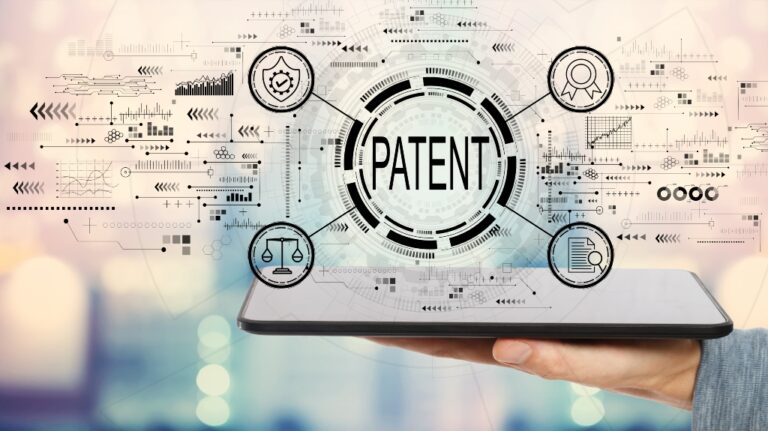
We’ve been thinking about AI a lot lately, and only in part because we use it so much around here. In just a few years across every economic sector, AI has become a faithful co-creator and innovator, contributing to architecture, healthcare, graphic design, aerospace engineering, and beyond. Ever since Darth “He Is More Machine Than Man” Vader first donned his gear after his fiery battle with Obi-Wan, the line between human ingenuity and machine-generated creation has continued to blur.
Increasingly autonomous AI has been driving innovation in ways once reserved for R&D teams and seasoned creatives, and with potentially patentable results. Real-world examples range from IKEA’s AI-designed furniture—“trippy, retro, and inspiring,” said Fast Company—to personalized Nutella containers to Rentosertib, an AI-designed anti-fibrotic drug named currently in clinical trials on humans.
If AI conceives of a new idea, taking actions that if done by a human, would unquestionably be patentable, can it be named as an inventor?
Surprisingly, this question has been settled for years.
The Legal Challenge
A patent may be awarded to anyone who invents or discovers any new and useful process, machine, manufacture, or composition of matter that is novel, not obvious, and useful. 35 U.S.C. §§ 101-103.
Imagine an AI system trained in acoustic physics that generates an innovative soundproofing material. The finished product is a micro-lattice structure with a network of tiny, repeating geometric shapes precisely designed to trap, scatter, and absorb sound waves. It blocks noise like nothing else before, and it meets all patentability criteria.
If an AI comes up with a new idea—taking steps that, if done by a human, would clearly be considered inventive—can it be named as the inventor?
Can AI be the named inventor?
No.
Not yet.
The Case That Set The Standard: Thaler v. Vidal
In 2019, Dr. Stephen Thaler filed patent applications for two inventions generated by his AI system named DABUS. One invention was a food container designed to improve grip and heat transfer. The other was a flashing light beacon optimized to attract attention in emergencies. Thaler listed DABUS as the sole inventor on both applications, asserting that the AI (not he) was responsible for the inventive contributions.
The USPTO rejected the applications, citing the Patent Act’s requirement that an inventor must be a natural person. Thaler appealed the decision, and the appellate court with jurisdiction over patent matters upheld the rejection. It wasn’t a close call.
The court held that, under current law, an “inventor” must be a human being. The ruling emphasized that the Patent Act is clear on this point. Under 35 U.S.C. § 100(f), an ‘inventor’ is defined as an individual—interpreted by courts to mean a human being. The statute uses terms like “himself or herself,” reinforcing that intent. End of inquiry.
The Court’s decision was that Congress sets the requirements for issuing patents and that it had already spoken on this point. The decision did not (and could not) touch on ethics or efficiency or whether an AI invention was or wasn’t a good idea. Until Congress amends the law, courts have no authority to extend inventorship to non-human entities.
Worse still, if Thaler’s DABUS system was the sole inventor, no human can truthfully claim to have conceived the idea. AI can’t be named as an inventor, and falsely naming a human as one risks invalidating the patent. In other words, if no one qualifies as a legitimate inventor, the invention falls outside the bounds of patent protection altogether.
The Gray Zone: AI-Assisted Invention
While AI cannot legally be named as an inventor, this doesn’t mean AI-assisted inventions are off-limits for patent protection. Most innovation today exists in a gray zone where humans and machines collaborate.
The USPTO has been on top of this. In February 2024, the USPTO issued formal guidance on AI-assisted inventions, aiming to clarify how traditional inventorship rules apply when AI plays a role in the creative process. The key takeaway? If a human makes a “significant contribution” to the invention, they can be named as the inventor, even if AI was involved.
There is no rigid test or checklist. Instead, the USPTO relies on long-standing inventorship principles, especially around conception (the formation of the complete idea) and whether human involvement meaningfully shaped the final invention.
For example, an AI system generates a hundred potential chemical compounds and a researcher reviews them, selects the most promising one, and refines it into a viable drug. That is inventorship on the part of the researcher. Contrast that with the human merely submitting the AI’s output without further development or judgment.
Who Owns What?
Recognizing AI inventorship would require a reworking of the legal mechanisms that rely on a human inventor’s ability to act, assign rights, and participate in litigation.
• Human inventors are the default owners of their inventions and can assign rights through contracts, employment agreements, or research collaborations. AI systems cannot legally own property.
• AI systems have no legal capacity to consent to a rights transfer or enter into agreements.
• If ownership is contested, there is no established mechanism for resolving disputes involving non-human inventors, leading to uncertainty over who legally owns the invention.
• In infringement disputes, human inventors often provide testimony about conception, development, and the invention’s context; this is something AI systems cannot do.
What You Can Do Now
AI is a powerful tool, but in patent law, humans still do the inventing. As innovation increasingly draws on machine-generated insights, it is essential to manage the human role with care and clarity.
Keep clear records of contributions and flag AI involvement early. Use provisional applications if inventorship is still evolving. Most importantly, work with counsel familiar with AI-related patent strategy.
The future of invention may be powered by AI, but the path to protection still runs through people. For now.
Curious how AI could impact your IP? Let’s talk. Book a consultation to explore your options.